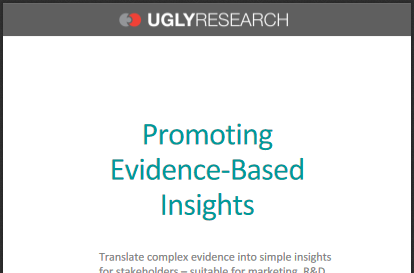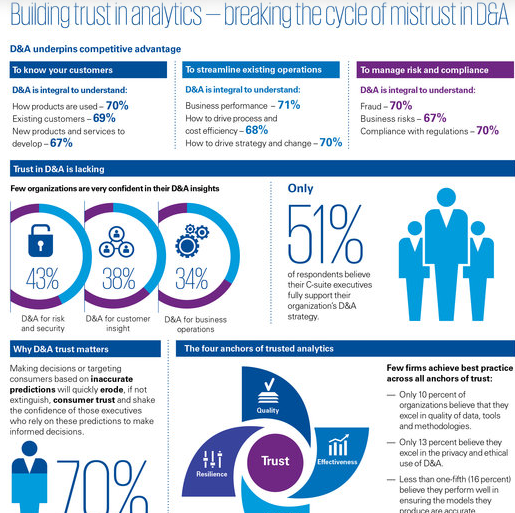
This week we examine how executives can more fully grasp complex evidence/analysis affecting their outcomes – and how analytics professionals can better communicate these findings to executives. Better performance and more trust are the payoffs.
1. Show how A → B. Our new guide to Promoting Evidence-Based Insights explains how to engage stakeholders with a data value story. Shape content around four essential elements: Top-line, evidence-based, bite-size, and reusable. It’s a suitable approach whether you’re in marketing, R&D, analytics, or advocacy.
No knowledge salad. To avoid tl;dr or MEGO (My Eyes Glaze Over), be sure to emphasize insights that matter to stakeholders. Explicitly connect specific actions with important outcomes, identify your methods, and provide a simple visual – this establishes trust and crediblity. Be succint; you can drill down into detailed evidence later. The guide is free from Ugly Research.


2. Lack of analytics understanding → Lack of trust.
Great stuff from KPMG: Building trust in analytics: Breaking the cycle of mistrust in D&A. “We believe that organizations must think about trusted analytics as a strategic way to bridge the gap between decision-makers, data scientists and customers, and deliver sustainable business results. In this study, we define four ‘anchors of trust’ which underpin trusted analytics. And we offer seven key recommendations to help executives improve trust throughout the D&A value chain…. It is not a one-time communication exercise or a compliance tick-box. It is a continuous endeavor that should span the D&A lifecycle from data through to insights and ultimately to generating value.”
Analytics professionals aren’t feeling the C-Suite love. Information Week laments the lack of transparency around analytics: When non-data professionals don’t know or understand how it is performed, it leads to a lack of trust. But that doesn’t mean the data analytics efforts themselves are not worthy of trust. It means that the non-data pros don’t know enough about these efforts to trust them.


3. Execs understand advanced analytics → See how to improve business
McKinsey has an interesting take on this. “Execs can’t avoid understanding advanced analytics – can no longer just ‘leave it to the experts’ because they must understand the art of the possible for improving their business.”
Analytics expertise is widespread in operational realms such as manufacturing and HR. Finance data science must be a priority for CFOs to secure a place at the planning table. Mary Driscoll explains that CFOs want analysts trained in finance data science. “To be blunt: When [line-of-business] decision makers are using advanced analytics to compare, say, new strategies for volume, pricing and packaging, finance looks silly talking only in terms of past accounting results.”
4. Macroeconomics is a pseudoscience.
NYU professor Paul Romer’s The Trouble With Macroeconomics is a widely discussed, skeptical analysis of macroeconomics. The opening to his abstract is excellent, making a strong point right out of the gate. Great writing, great questioning of tradition. “For more than three decades, macroeconomics has gone backwards. The treatment of identification now is no more credible than in the early 1970s but escapes challenge because it is so much more opaque. Macroeconomic theorists dismiss mere facts by feigning an obtuse ignorance about such simple assertions as ‘tight monetary policy can cause a recession.'” Other critics also seek transparency: Alan Jay Levinovitz writes in @aeonmag The new astrology: By fetishising mathematical models, economists turned economics into a highly paid pseudoscience.
5. Better health evidence to a wider audience.
From the Evidence Live Manifesto: Improving the development, dissemination. and implementation of research evidence for better health.
“7. Evidence Communication…. 7.2 Better communication of research: High quality, important research that matters has to be understandable and informative to a wide audience. Yet , much of what is currently produced is not directed to a lay audience, is often poorly constructed and is underpinned by a lack of training and guidance in this area.” Thanks to Daniel Barth-Jones (@dbarthjones).
Posted by Tracy Allison Altman on 11-Nov-2016.
Photo credit: Steve Lav – Trust on Flickr








